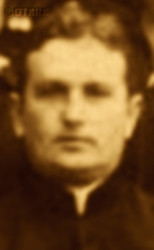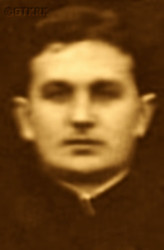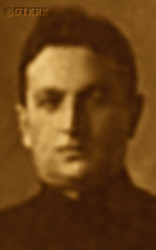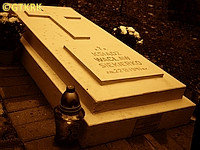Roman Catholic
St Sigismund parish
05-507 Słomczyn
85 Wiślana Str.
Konstancin deanery
Warsaw archdiocese, Poland
full list:
displayClick to display full list

searchClick to search full list by categories
wyświetlKliknij by wyświetlić pełną listę po polsku

szukajKliknij by przeszukać listę wg kategorii po polsku

Martyrology of the clergy — Poland
XX century (1914 – 1989)
personal data
surname
SIEKIERKO
forename(s)
Vaclav (pl. Wacław)
function
diocesan priest
creed
Latin (Roman Catholic) Church RCmore on
en.wikipedia.org
[access: 2014.09.21]
diocese / province
Vilnius archdiocesemore on
en.wikipedia.org
[access: 2013.05.19]
Vilnius diocesemore on
en.wikipedia.org
[access: 2013.05.19]
RC Military Ordinariate of Polandmore on
en.wikipedia.org
[access: 2014.12.20]
academic distinctions
Doctor of Canon Law
date and place
of death
22.06.1941

Vilniustoday: Vilnius city dist., Vilnius Cou., Lithuania
more on
en.wikipedia.org
[access: 2022.01.06]
details of death
In 1920, during the Polish–Russian War of 1919‐1921, drafted into the Polish Army as a chaplain. Served in the 1st Podhale Rifle Regiment of the Mountain Division (on 10.08.1920 renamed the 21st Mountain Infantry Division). The Regiment at some point took part, among others, in the Kiev Expedition in 05‐06.1920; then, during the withdrawal in battles under Russian pressure, among others in the defense of Brest on 30.07‐01.08.1920; from 16.08.1920 in the Polish counterattack from the Wieprz River, in the central section of the attack, attacking towards Łuków — as part of the Battle of Warsaw, known as „Miracle on the Vistula” — including in the battles for Białystok on 22.08.1920. The Regiment ended its participation in combat during the second most important battle of the war, the Battle of the Neman River on 20‐26.09.1920, taking part, among others, in the battles for Sokółka and Grodno.
On 12.04.1921 transferred to the reserve of the Polish Army. In 1923, 1924, 1925, 1927 and 1929 appointed again reserve chaplain of the Polish Army (from 25.11.1926 each time for a statutory period of 2 years).
After German and Russian invasion of Poland in 09.1939 and start of the World War II, after German attack on 22.06.1941 of their erstwhile ally, Russians, the bomb that fell onto St Rafael the Archangel church in Vilnius broke through the ceiling and the floor and fell into the basement, where he with a number of people had taken refuge and perished.
cause of death
shelling (bombardment)
perpetrators
Germans
sites and events
Ribbentrop‐MolotovClick to display the description, Pius XI's encyclicalsClick to display the description, Polish‐Russian war of 1919‐1921Click to display the description
date and place
of birth
23.07.1895Birth certification on:
skanoteka.genealodzy.pl
[access: 2025.08.19]

Ciechanowiectoday: Ciechanowiec gm., Wysokie Mazowieckie pov., Podlaskie voiv., Poland
more on
en.wikipedia.org
[access: 2022.01.06]
alt. dates and places
of birth
11.07.1902
(Julian calendar)
parents
SIEKIERKO Alexander
🞲 ?, ? — 🕆 ?, ?

PEŁSZYK Marianne
🞲 ?, ? — 🕆 ?, ?
baptism
04.08.1895Birth certification on:
skanoteka.genealodzy.pl
[access: 2025.08.19]

Ciechanowiectoday: Ciechanowiec gm., Wysokie Mazowieckie pov., Podlaskie voiv., Poland
more on
en.wikipedia.org
[access: 2022.01.06]
Holy Trinity RC church
presbyter (holy orders)
ordination
07.04.1918

Sankt Petersburgtoday: Saint Petersburg city, Russia
more on
en.wikipedia.org
[access: 2020.07.31]
positions held
1935 – 1941
prefect — Vilniustoday: Vilnius city dist., Vilnius Cou., Lithuania
more on
en.wikipedia.org
[access: 2022.01.06] ⋄ secondary schools — i.a., in the first months of the Lithuanian occupation in 1939 conducted catechesis at the Adam Mickiewicz Gymnasium (soon renamed to Gymnasium No. 3)
from c. 1935
defender of the marriage bond — Vilniustoday: Vilnius city dist., Vilnius Cou., Lithuania
more on
en.wikipedia.org
[access: 2022.01.06] ⋄ Archbishop's Metropolitan Court
1923 – 1935
prefect — Švenčionystoday: Švenčionys eld., Švenčionys dist., Vilnius Cou., Lithuania
more on
en.wikipedia.org
[access: 2020.11.13] ⋄ Joseph Piłsudski's State Gymnasium (prob.) ⋄ All the Saints RC parish ⋄ Švenčionystoday: Švenčionys eld., Švenčionys dist., Vilnius Cou., Lithuania
more on
en.wikipedia.org
[access: 2020.11.13] RC deanery
1920 – 1921
RC military chaplain — 1st Podhale Rifle Regiment, Polish Armed Forces — by L. 2845 decree of the Commander‐in‐Chief of 14.04.1921, at the request of the Bishop's Curia of the Polish Army, demobilised from the Polish Army; transferred to the reserves of the Polish Army, verified as a chaplain of the Polish army, with seniority from 01.06.1919, in the rank of captain
1919 – 1927
PhD student — Warsawtoday: Warsaw city pov., Masovia voiv., Poland
more on
en.wikipedia.org
[access: 2021.10.09] ⋄ canon law, University of Warsaw [i.e. University of Warsaw (from 1945) / clandestine University (1939‐1945) / Joseph Piłsudski University (1935‐1939) / University of Warsaw (1915‐1935) / Imperial University of Warsaw (1870‐1915)]
1918 – 1919
vicar — Siemiatyczetoday: Siemiatycze urban gm., Siemiatycze pov., Podlaskie voiv., Poland
more on
en.wikipedia.org
[access: 2022.01.06] ⋄ Assumption of the Blessed Virgin Mary RC parish ⋄ Drohiczyntoday: Drohiczyn gm., Siemiatycze pov., Podlaskie voiv., Poland
more on
en.wikipedia.org
[access: 2020.12.11] RC deanery
till 1918
student — Sankt Petersburgtoday: Saint Petersburg city, Russia
more on
en.wikipedia.org
[access: 2020.07.31] ⋄ Imperial Roman Catholic Spiritual Academy (1842‐1918)
from 1913
student — Vilniustoday: Vilnius city dist., Vilnius Cou., Lithuania
more on
en.wikipedia.org
[access: 2022.01.06] ⋄ philosophy and theology, Theological Seminary
sites and events
descriptions
Ribbentrop‐Molotov: Genocidal Russian‐German alliance pact between Russian leader Joseph Stalin and German leader Adolf Hitler signed on 23.08.1939 in Moscow by respective foreign ministers, Mr. Vyacheslav Molotov for Russia and Joachim von Ribbentrop for Germany. The pact sanctioned and was the direct cause of joint Russian and German invasion of Poland and the outbreak of the World War II in 09.1939. In a political sense, the pact was an attempt to restore the status quo ante before 1914, with one exception, namely the „commercial” exchange of the so‐called „Kingdom of Poland”, which in 1914 was part of the Russian Empire, fore Eastern Galicia (today's western Ukraine), in 1914 belonging to the Austro‐Hungarian Empire. Galicia, including Lviv, was to be taken over by the Russians, the „Kingdom of Poland” — under the name of the General Governorate — Germany. The resultant „war was one of the greatest calamities and dramas of humanity in history, for two atheistic and anti‐Christian ideologies — national and international socialism — rejected God and His fifth Decalogue commandment: Thou shall not kill!” (Abp Stanislav Gądecki, 01.09.2019). The decisions taken — backed up by the betrayal of the formal allies of Poland, France and Germany, which on 12.09.1939, at a joint conference in Abbeville, decided not to provide aid to attacked Poland and not to take military action against Germany (a clear breach of treaty obligations with Poland) — were on 28.09.1939 slightly altered and made more precise when a treaty on „German‐Russian boundaries and friendship” was agreed by the same murderous signatories. One of its findings was establishment of spheres of influence in Central and Eastern Europe and in consequence IV partition of Poland. In one of its secret annexes agreed, that: „the Signatories will not tolerate on its respective territories any Polish propaganda that affects the territory of the other Side. On their respective territories they will suppress all such propaganda and inform each other of the measures taken to accomplish it”. The agreements resulted in a series of meeting between two genocidal organization representing both sides — German Gestapo and Russian NKVD when coordination of efforts to exterminate Polish intelligentsia and Polish leading classes (in Germany called «Intelligenzaktion», in Russia took the form of Katyń massacres) where discussed. Resulted in deaths of hundreds of thousands of Polish intelligentsia, including thousands of priests presented here, and tens of millions of ordinary people,. The results of this Russian‐German pact lasted till 1989 and are still in evidence even today. (more on: en.wikipedia.orgClick to attempt to display webpage
[access: 2015.09.30])
Pius XI's encyclicals: Facing the creation of two totalitarian systems in Europe, which seemed to compete with each other, though there were more similarities than contradictions between them, Pope Pius XI issued in 03.1937 (within 5 days) two encyclicals. In the „Mit brennender Sorge” (Eng. „With Burning Concern”) published on 14.03.1938, condemned the national socialism prevailing in Germany. The Pope wrote: „Whoever, following the old Germanic‐pre‐Christian beliefs, puts various impersonal fate in the place of a personal God, denies the wisdom of God and Providence […], whoever exalts earthly values: race or nation, or state, or state system, representatives of state power or other fundamental values of human society, […] and makes them the highest standard of all values, including religious ones, and idolizes them, this one […] is far from true faith in God and from a worldview corresponding to such faith”. On 19.03.1937, published „Divini Redemptoris” (Eng. „Divine Redeemer”), in which criticized Russian communism, dialectical materialism and the class struggle theory. The Pope wrote: „Communism deprives man of freedom, and therefore the spiritual basis of all life norms. It deprives the human person of all his dignity and any moral support with which he could resist the onslaught of blind passions […] This is the new gospel that Bolshevik and godless communism preaches as a message of salvation and redemption of humanity”… Pius XI demanded that the established human law be subjected to the natural law of God , recommended the implementation of the ideal of a Christian state and society, and called on Catholics to resist. Two years later, National Socialist Germany and Communist Russia came together and started World War II. (more on: www.vatican.vaClick to attempt to display webpage
[access: 2023.05.28], www.vatican.vaClick to attempt to display webpage
[access: 2023.05.28])
Polish‐Russian war of 1919‐1921: War for independence of Poland and its borders. Poland regained independence in 1918 but had to fight for its borders with former imperial powers, in particular Russia. Russia planned to incite Bolshevik‐like revolutions in the Western Europe and thus invaded Poland. Russian invaders were defeated in 08.1920 in a battle called Warsaw battle („Vistula river miracle”, one of the 10 most important battles in history, according to some historians). Thanks to this victory Poland recaptured part of the lands lost during partitions of Poland in XVIII century, and Europe was saved from the genocidal Communism. (more on: en.wikipedia.orgClick to attempt to display webpage
[access: 2014.12.20])
sources
personal:
www.bialystok.opoka.org.plClick to attempt to display webpage
[access: 2013.01.06], skanoteka.genealodzy.plClick to attempt to display webpage
[access: 2025.08.19]
bibliographical:
„Vilnius archdiocese clergy martyrology 1939‐1945”, Fr Thaddeus Krahel, Białystok, 2017
original images:
www.podbrodzie.info.plClick to attempt to display webpage
[access: 2015.05.09], www.podbrodzie.info.plClick to attempt to display webpage
[access: 2017.06.16], www.podbrodzie.info.plClick to attempt to display webpage
[access: 2017.06.16], www.wilnoteka.ltClick to attempt to display webpage
[access: 2022.01.06]
LETTER to CUSTODIAN/ADMINISTRATOR
If you have an Email client on your communicator/computer — such as Mozilla Thunderbird, Windows Mail or Microsoft Outlook, described at WikipediaPatrz:
en.wikipedia.org, among others — try the link below, please:
LETTER to CUSTODIAN/ADMINISTRATORClick and try to call your own Email client
If however you do not run such a client or the above link is not active please send an email to the Custodian/Administrator using your account — in your customary email/correspondence engine — at the following address:

giving the following as the subject:
MARTYROLOGY: SIEKIERKO Vaclav
To return to the biography press below:
 Click to return to biography
Click to return to biography











